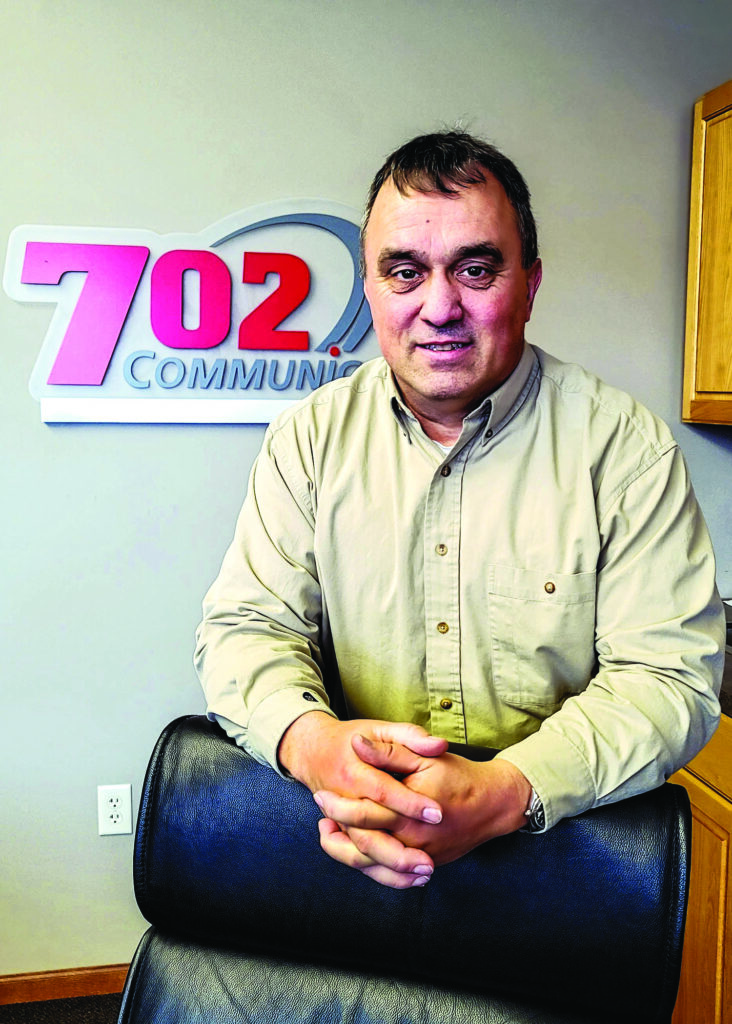
In his 23 years with Moorhead-based 702 Communications, Randy Farwell has helped customers navigate the rapidly changing telephone and internet landscape, from analog to VOIP technology and copper wires to fiberoptic cables. (Photo/Nancy Hanson.)
Nancy Edmonds Hanson
Randy Farwell was the fifth person hired when six small-town phone companies joined forces to compete with US West in 1999. Naming their new enterprise 702 Communications in honor of its street address on Main Avenue, the founders stepped into a world of copper telephone wires, dial-up internet and telephones that sat on desks, tethered with curling cords.
Twenty-two years – a millennium in the fast-moving world of high-tech – the Moorhead-based company is on the cutting edge in a world that has changed dramatically in just two decades. Serving businesses and apartments throughout the greater Fargo-Moor head area, 702 employs its 40 miles of fiber optic cable to provide not only what used to be called telephone service, but also internet, network systems and security, cameras and security systems, and the IT (information technology) expertise to keep it all running.
Back in 1999, when Randy came aboard, 702 Communication was a newcomers on the Wild West landscape of telephony. Its adventure was spurred by the Telecommunications Act of 1996, opening up local phone markets to all comers that had long been the private turf of AT&T and the Baby Bells like US West.
“We’re classified as a CLEC – a ‘compact local exchange carrier,’” he explains. “Federal deregulation gave us the right to use AT&T’s copper trunk lines and compete in our local area. It opened the door.”
As Randy tells it, 702 Communications was the brainchild of a half dozen independent rural carriers, including Carving Communications of Per ham, Red River Telephone of Abercrombie, the local telephone systems in Barnesville and Rothsay, and Otter Tail Telcom of Fergus Falls. Along with a sixth, they formed a joint venture they dubbed Val-Ed to provide interactive educational video to schools and libraries, a service in which it’s still involved. The firm rapidly expanded into business and residential service, acquiring two local internet providers, Moorhead Public Service’s GoMoorhead and Forum Communication’s i29 Wireless.
From the beginning, he says, “Our services were quite easy to sell. Businesses were quite open to us, mostly because of our pricing. We came in with different formats than what US West had at the time. Remember, those were the days when a phone line ran from $30 to $40 a month and long-distance calls could cost $1 a minute.”
Instead of the telephones that older adults grew up with – complete with dial tones, operators and humans who answered business phones when they rang, or as they’re called now, POTS (“plain old telephone systems”) – today 702 concentrates primarily on VoIP. That’s “voice over internet protocol.” In other words, instead of those overhead telephone wires, your calls (and video, graphics, games and all the rest) zooms almost instantaneously to its destination over the internet. VoIP systems open the door to more flexible systems with higher sound quality, he notes, and at the same time can offer lower prices.
702 Communications’ role as an internet provider was vital from the start. At the beginning, the company offered dial-up service at a then-blistering speed of 56K, or 56 megabits per second. That evolved into DSL, allowing simultaneous use of the phone and the internet on the same line. Today, speeds of 1 megabyte (1,000 per second) have become common, driven by all kinds of increased demands, from gaming and Netflix to video calling and countless other business needs. “As the internet got better, content providers have come up with all kinds of new ideas,” he observes. That – and the pandemic, which boosted demands for online communication – drives the continual need for greater bandwidth.
Raised on a farm near Alberta, Minnesota, Randy could never envision how he’d spend his entire career keeping up with technology. After earning degrees from the North Dakota College of Science and North Dakota State University in agricultural economics, he started out selling pagers and business-band radio equipment. At the end of a stint in the cellular industry, he found himself in 702’s then-brand-new office pitching his Alexandria, Minnesota, company’s services. Instead, 702 hired him to be its first sales representative.
Now looking toward retirement over the next 18 months, Randy will soon take a breath after 20 years of learning at break-neck speed. He and his wife Sherri, who recently retired as the chief financial officer of the city of Dilworth, plan to spend more time at their cabin near Waubun. They have one daughter, Claire, who works as a jailer in Cass County.
Providing local telecommunications services has been a fiercely competitive enterprise, he says, from 702’s earliest days. He and colleagues are proud to point out that theirs is the only one of all competitors in the market that started out local … and remains entirely local to this day.
Today their focus is fourfold. The first, where Randy concentrates, is business-to-business sales, as well as providing phone and internet lines and Dish TV to multi-unit residential developments. They provide wholesale bandwidth to many of Verizon’s and AT&T’s cell towers through their fiber connections. And a growing part of their business is so-called managed service, with a staff providing the technical expertise to set up, monitor and troubleshoot the complex systems that now keep businesses and organizations in touch with the public.
Randy, though, hastens to confess that he is not himself one of those technical wizards. “In the beginning, I tried to BS one of the technical guys at a customer’s company. He knew I was really reaching from the moment I opened my mouth,” he admits, “and I got caught.
“That was a good lesson. Ever since, I speak to my own level of knowledge.” Instead, he tells clients proudly, “I know people who know things. I just know enough to be dangerous.”


